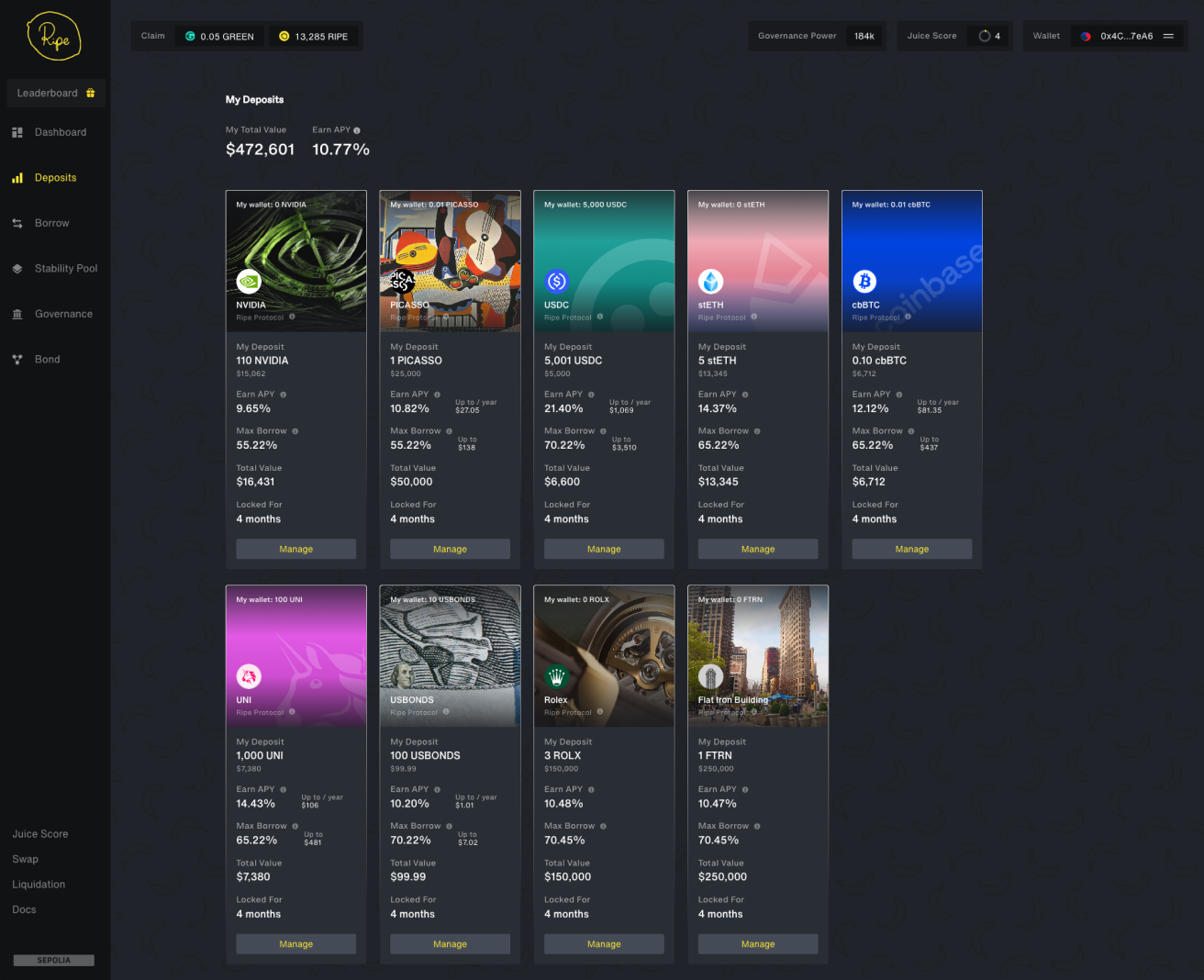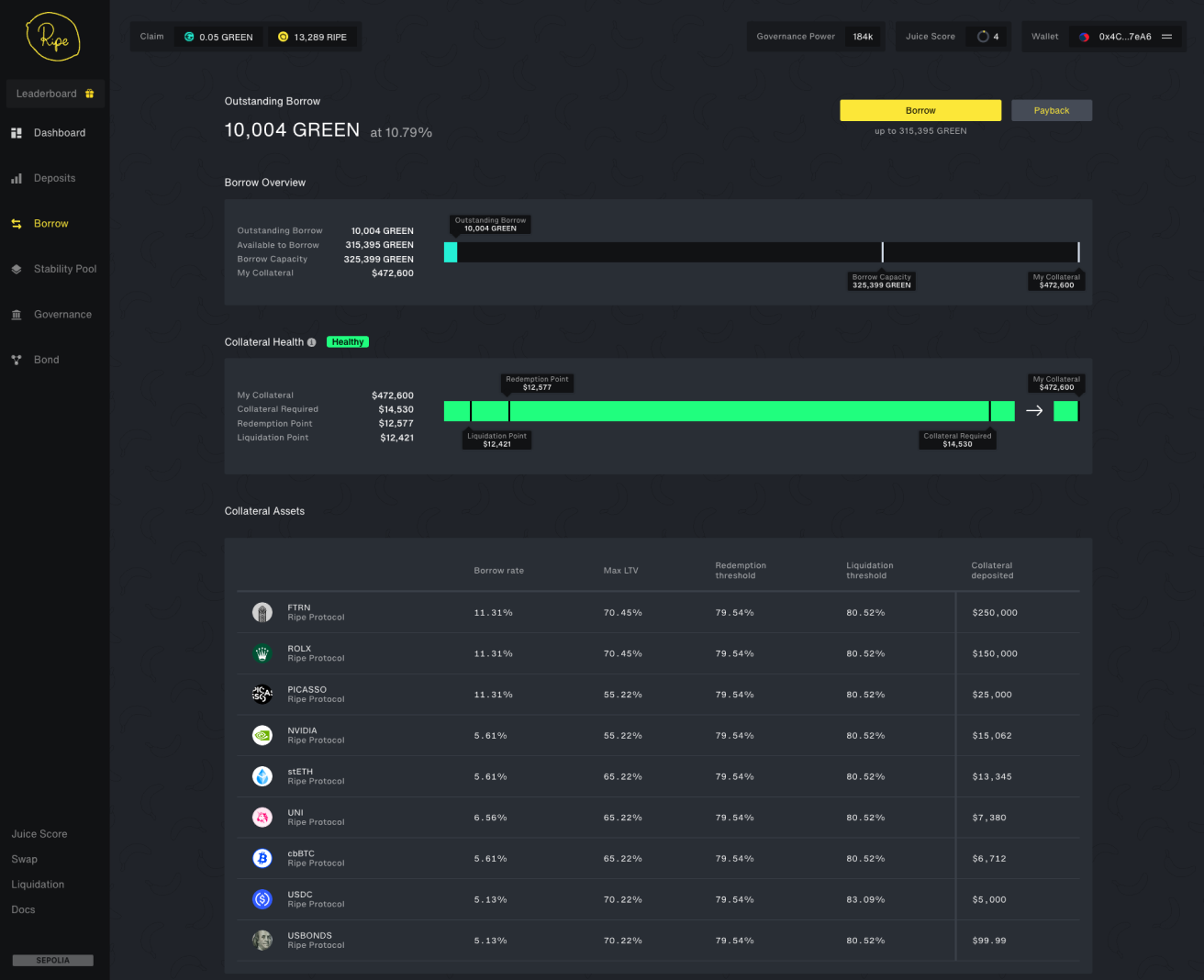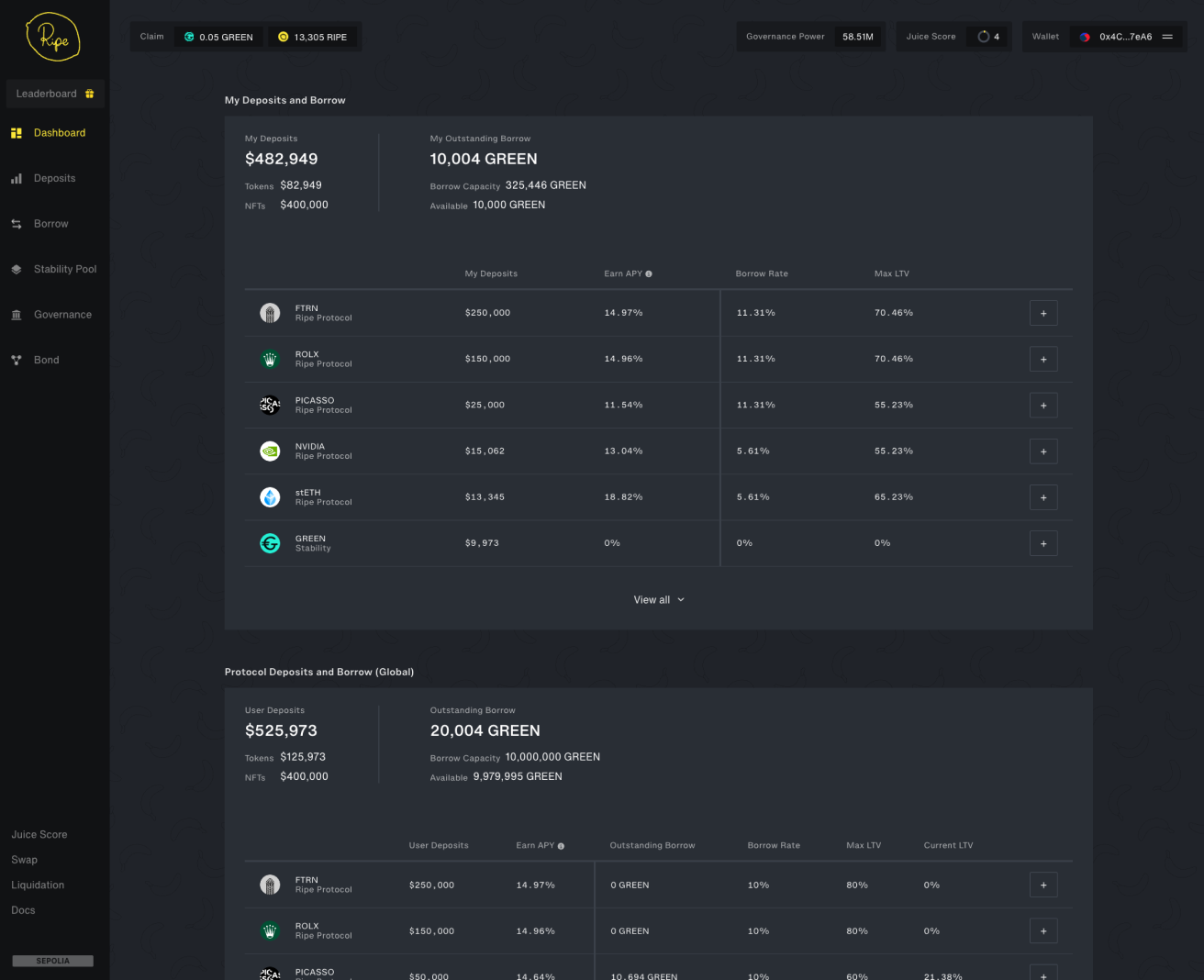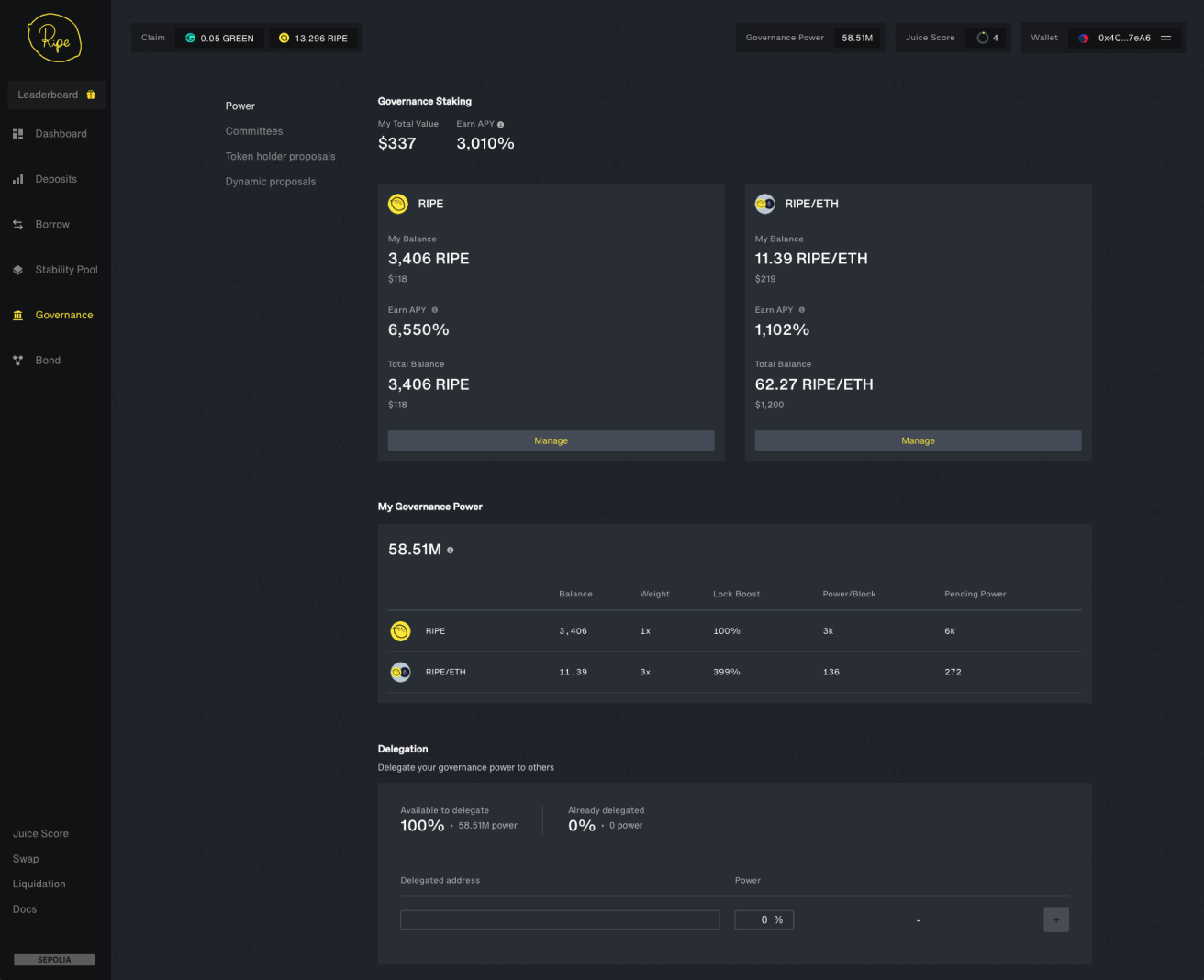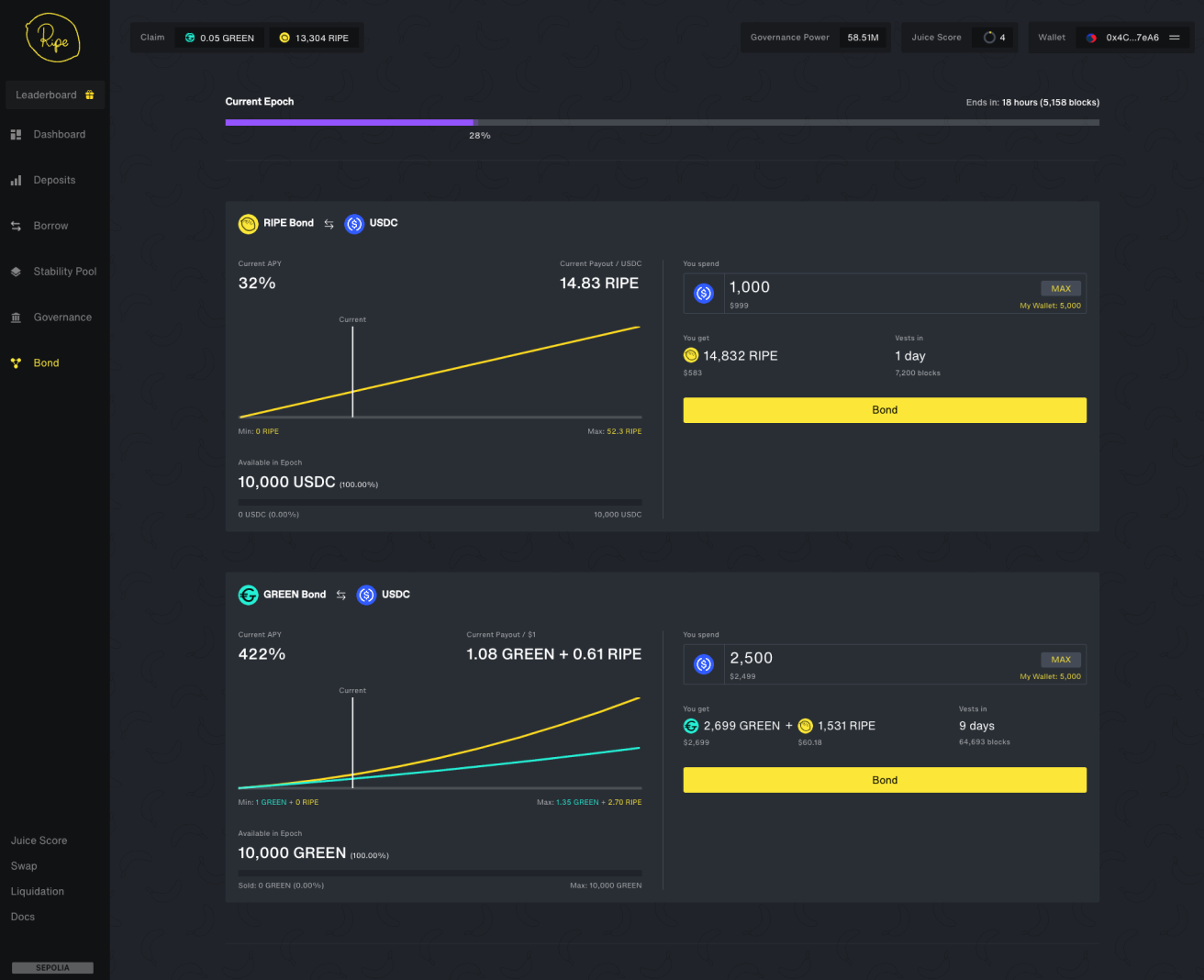Unlocking Global Wealth: Ripe Protocol Bridges DeFi and Real-World Assets
For too long, the benefits of DeFi have been limited to holders of crypto-native assets. But a seismic shift is underway: traditional financial assets—bonds, equities, private credit, commodities—and personal assets like homes, cars, jewelry, art, and even livestock are being tokenized and brought onchain. DeFi is now within reach for the global billions.
Enter Ripe Protocol. As real-world assets are tokenized, Ripe empowers users to unlock and tap into their full value. Ripe enables individuals to earn yield on or borrow against any asset, opening doors to wealth creation and credit access previously unimaginable.
Read more about Ripe’s vision and how it was born out of Mick’s experiences.
Table of Contents
The Problem: why it matters and why it’s urgent
The Solution: how Ripe Protocol is the answer
Protocol Status: how it works and where we are
Team: why this team is uniquely capable
Market Opportunity: how tokenization is primed for meteoric growth
Competitive Landscape: how other protocols compare
Go To Market: our plans for growth and distribution
Business Model: how the economics make sense
The Problem

Summary
Unlocking the value of real-world assets remains elusive.
Trillions of dollars in global assets sit idle, generating no yield (e.g., homes, land, equities, art, jewelry).
Most real-world assets cannot be used as collateral for a loan. When available, it's either inaccessible for most (limited to the ultra-wealthy through private banking) or predatory (pawn shops).
DeFi has the potential to address these challenges, and with the rise of tokenization, this potential is becoming a reality.
However, existing DeFi protocols are falling short, lacking the necessary infrastructure for tokenized assets—especially regulated and non-fungible ones.
Blue-chip lending protocols cannot support regulated or permissioned assets due to compliance issues; nor can they support unique, non-fungible assets, which make up a large portion of the real-world asset market.
New upstart protocols focus on specific verticals, handling some of these assets (regulated or non-fungible), but lender liquidity is fragmented and borrower experience is poor (higher rates, need to manage multiple loans across many protocols).
I. Unlocking the Value of Idle Assets Remains Elusive

Trillions in Idle Assets are Producing No Yield
Globally, trillions of dollars in valuable assets—homes, land, art, jewelry, cars—remain unproductive, generating no income for their owners. In crypto, this issue is mirrored by non-staking tokens and high-value NFTs like CryptoPunks, which hold significant value but produce no yield. Asset owners are left waiting for potential appreciation, with no means to transform their holdings into income-generating assets.
Exclusive Credit Access and Predatory Lending Practices
Leveraging assets as collateral to access credit is a privilege reserved for the ultra-wealthy. For most individuals, borrowing against assets like public equities or family heirlooms is either impossible or comes with exorbitant interest rates and opaque terms. Pawn shops charge excessive rates, lack transparency, and offer no guarantee of fair deals. Traditional financial institutions impose high minimum requirements, effectively shutting out a vast segment of potential borrowers. Owners of rural land, accounts receivable, or stakes in private companies find themselves unable to unlock liquidity from their holdings.
In crypto, while asset-backed borrowing is somewhat more accessible, it's largely confined to blue-chip assets. The ability to leverage yield-bearing positions, LP tokens, tokenized RWAs, and a broader range of assets remains out of reach for most. Consequently, the majority still find credit access backed by diverse holdings a distant reality.

II. Limitations of Current DeFi Lending Protocols
DeFi holds the promise of addressing these yield and credit accessibility issues, yet existing protocols fall short. Leading protocols like Aave, MakerDAO, and Compound were developed before the rise of tokenized RWAs and are ill-equipped to handle their complexities, especially those that are permissioned, regulated, or non-fungible.
Compliance Challenges with Regulated Assets
The open nature of major DeFi lending protocols poses compliance risks for borrowers using regulated tokenized assets as collateral. Borrowing from anonymous lenders can lead to inadvertent engagement with illicit actors or sanctioned entities. Open liquidation mechanisms risk transferring regulated assets to unauthorized parties, creating compliance nightmares and deterring participation.
Compatibility Issues with non-fungible RWA
Most major DeFi lending protocols support only simple, fungible assets like stablecoins and select tokenized treasuries. NFTs have emerged as a pivotal technology for tokenizing unique real-world assets—individual real estate properties, luxury goods, collectibles—but these protocols lack NFT support due to fundamental differences from the ERC-20 token standard. Adding NFT compatibility is non-trivial, limiting these platforms' ability to engage with a significant portion of the RWA market.

III. The Ineffectiveness of Emerging Protocols
New upstart protocols attempt to bridge the gap but often focus narrowly on specific use cases or asset classes, failing to address the broader problems. In many cases, debt terms are as predatory as traditional pawn shops.
Liquidity Constraints and Limited Lender Pools
Because most new entrants are either a peer-to-peer or peer-to-pool model, they require lenders. However, their focus on specific asset verticals makes it challenging to attract this specialized lender capital. For regulated assets, mandatory KYC processes further shrink the pool of potential lenders. This fragmentation leads to liquidity shortages, making it difficult for borrowers to secure timely loans—or any loans at all.
Poor Borrower Experience and Increased Risk
To entice lenders amidst liquidity struggles, protocols offer high interest rates, resulting in unfavorable terms for borrowers. Users may wait indefinitely for loans, only to face predatory conditions worse than traditional options. Managing multiple loans with varying maturity dates across different platforms becomes cumbersome and inefficient. Without the ability to leverage their overall portfolio to mitigate volatility in individual assets, borrowers face an increased risk of unnecessary liquidation.
The Solution

Summary
Ripe Protocol provides the missing infrastructure for tokenized assets.
Compliance-ready features to support regulated, permissioned real-world assets, including whitelist support, no counterparty risk (no lenders), no derivatives risk (no receipt tokens on deposit), and a unique liquidation system to handle transfer restrictions.
Users can earn yield on any asset, even previously idle, unproductive real-world assets. This is achieved through The Endaoment, where protocol revenues are pooled, invested, and yields are distributed back to depositors. Ripe's unique Bonding Mechanism bootstraps the Endaoment.
Borrowers benefit from a single loan backed by all their assets—including tokenized real-world assets and crypto-native assets (ERC-20 tokens, NFTs)—simplifying debt management and reducing liquidation risk.
Loans are denominated in GREEN, Ripe’s synthetic USD stablecoin similar to Maker’s DAI. With smart contracts as the counterparty instead of onchain lenders, loans are instant and debt terms are predictable and competitive.
Ripe employs various GREEN redemption methods to maintain the $1 peg and leverages the Bonding Mechanism and Stability Pool to ensure protocol-owned GREEN liquidity remains healthy and growing.
Ripe supports various NFT standards, opening doors to a broader non-fungible real-world asset market like individual real estate properties, fine art, luxury goods, and collectibles.
Ripe Protocol provides the missing infrastructure that empowers asset owners to tap into the full value of their assets. By overcoming the limitations of existing lending protocols, Ripe enables yield generation and offers a superior borrowing experience for both real-world and crypto-native assets.
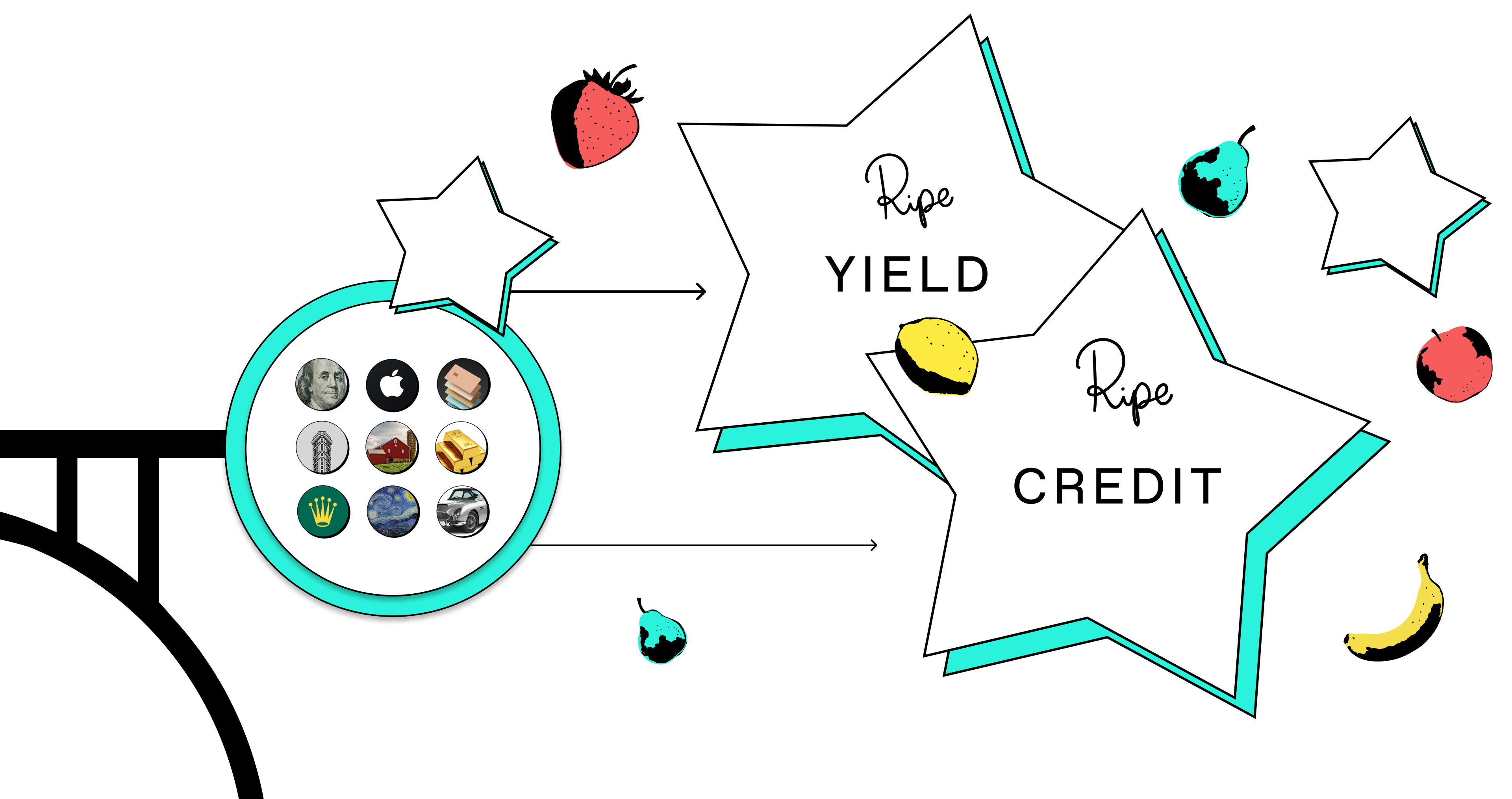
I. Unlocking Yield on Any Asset
Ripe Protocol revolutionizes asset utilization by enabling users to earn yield on any asset—real-world or crypto-native. At the heart of Ripe is the Endaoment, where all protocol revenue streams—interest payments, origination fees, liquidation fees—are pooled and invested in blue-chip stablecoin yield strategies like Aave and sDAI. Mirroring traditional endowments, the principal remains invested while only the gains are distributed to users. This allows depositors to earn consistent yield on their assets.
Our innovative Bonding Mechanism enables the protocol to act as a trusted borrower on behalf of users, accelerating the growth of the Endaoment and enhancing yield potential. For crypto-native assets, Ripe's extensible deposit framework paves the way for integration with other DeFi protocols, unlocking additional yield opportunities.

II. A Superior Borrowing Experience
One Loan Backed by Your Entire Portfolio
Borrowers benefit from the simplicity of a single loan backed by all their assets, including tokenized real-world assets, ERC-20 tokens, and NFTs. Each asset type is assigned specific risk parameters, such as interest rates and loan-to-value ratios. For instance, users might borrow up to 80% of their tokenized treasuries’ value but only 50% of a CryptoPunk NFT. This unified, multi-collateral approach simplifies debt management and leverages the full value of one's portfolio, reducing the risk of liquidation due to the volatility of individual assets.

Instant Loans with Competitive and Predictable Terms
By minting GREEN, a synthetic US dollar stablecoin similar to Maker's DAI, Ripe offers highly competitive debt terms without the need for traditional lenders or counterparties. Loans are instant, with predictable interest rates and no maturity date—interest simply accrues to the user's debt balance. This transparency and efficiency provide borrowers with a more favorable and straightforward borrowing experience.
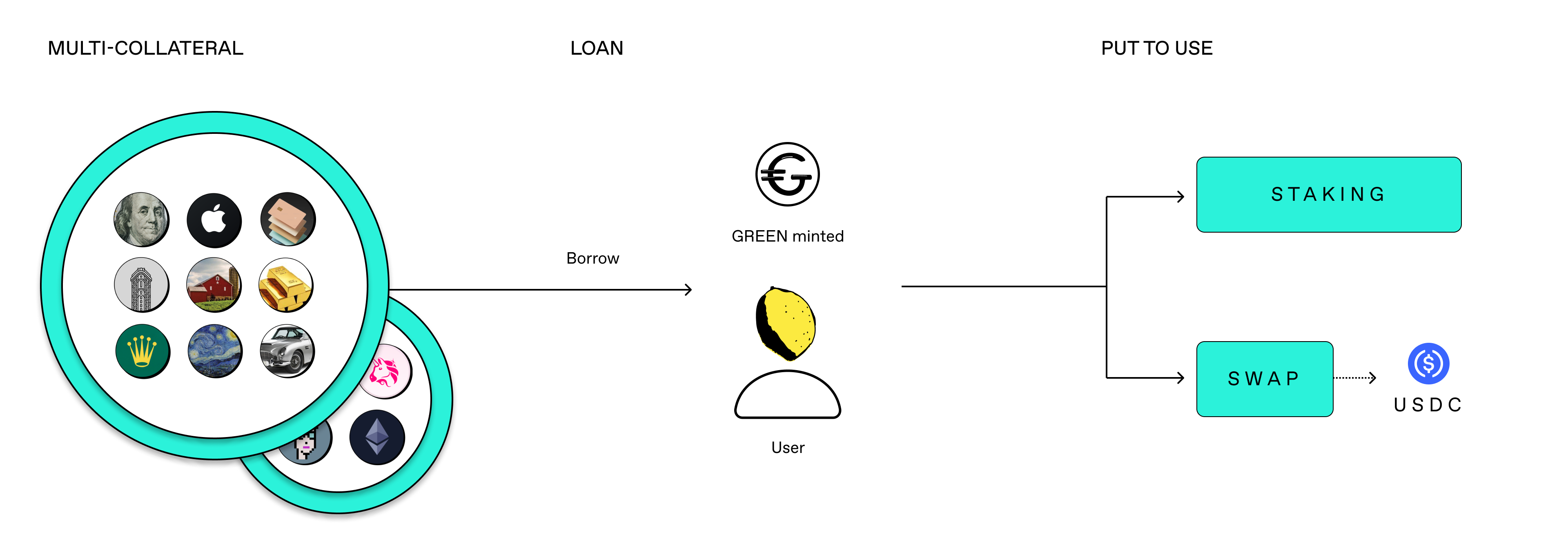
Ensuring GREEN's Liquidity and Stability
To ensure users can seamlessly convert GREEN to other stablecoins like USDC, Ripe Protocol incorporates mechanisms to build liquidity and maintain the $1 peg. The Bonding Mechanism and Stability Pool help grow protocol-owned liquidity. Users can redeem 1 GREEN for $1 worth of other assets within the Endaoment, liquidated assets in the Stability Pool, or collateral from risky debt positions. Governance tools within the Endaoment can also inject liquidity when necessary to protect the peg, ensuring stability and trust in the system.

III. Future-Proofed for Tomorrow's Assets
Ripe Protocol is designed to support the evolving landscape of tokenized assets, including permissioned, non-fungible, and regulated assets.
Compliance-Ready: Supporting Regulated, Permissioned Assets
Ripe eliminates counterparty uncertainty by using smart contracts as the sole intermediary. When users borrow against their assets, the protocol mints GREEN stablecoins directly to them, ensuring compliance and reducing risk. Robust allowlist modules enable token issuers to set permissions per asset or strategy. Whether using Ripe's built-in allowlist or integrating with external contracts, issuers can prevent unauthorized transfers during deposits, withdrawals, swaps, or liquidations, maintaining compliance with regulatory requirements.
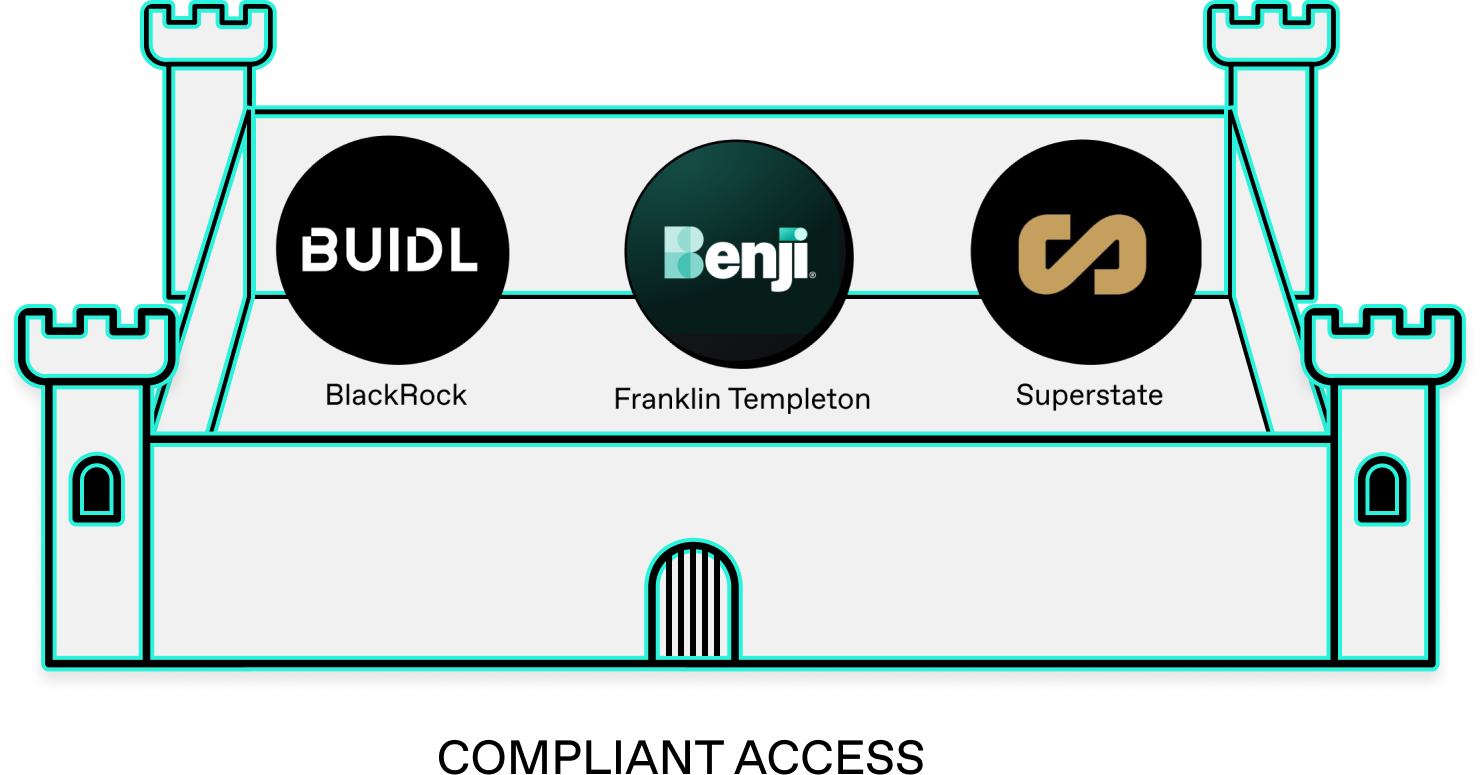
Built for the Future: Compatibility with Tokenized Assets
By supporting various NFT standards, Ripe opens the door to a broader RWA market, accommodating unique assets like individual properties, luxury goods, and collectibles. During our testnet seasons over the past year, we've successfully integrated assets such as Rolex watches, Tesla cars, and New York City real estate, demonstrating the protocol's versatility.
Our extensible strategy and deposit framework is highly modular and governed by RIPE token holders. This design ensures the protocol remains adaptable to emerging technologies and regulatory changes, making it resilient and future-proof in the rapidly evolving RWA landscape.
Protocol Status

Summary
Ripe Protocol is fully developed, tested, and audited—ready for launch.
Development started over two years ago; built from scratch, not a fork.
Initially deploying on Base L2, compatible with any EVM network.
Completed two comprehensive code audits with ChainSecurity, experts in Vyper (our codebase) and auditors of multiple lending protocols (Aave, Maker, Compound).
Conducted eight "seasons" on Sepolia testnet over the past 18 months, refining the protocol with our community.
Ready for Launch: Fully Developed, Tested, and Audited
Ripe Protocol's smart contracts and front-end are fully developed, rigorously tested, and audited—ready for imminent launch on Ethereum mainnet, with plans to expand to other EVM-compatible L1 and L2 networks.
Core Components
The Ripe Protocol is best understood by exploring its key components. Here’s a quick summary, with each component linking to the specific section of our interactive whitepaper where you can dive deeper.
💰 Deposits & Loans: Support for a wide range of digital assets—from traditional crypto assets to NFTs and RWAs (Real-World Assets).
🏦 The Endaoment: Collects protocol revenues, invests them, and distributes yield—a sustainable rewards system mirroring traditional endowments.
🌱 Bonding Mechanism: A fundraising tool that accelerates the growth of the Endaoment, enhancing yield potential for users.
💵 GREEN token: The protocol's stablecoin, enabling instant and competitive loans without requiring a counterparty.
💧 Stability Pool: Absorbs risky debt during liquidations, maintaining system stability and protecting users.
🏛️ RIPE token: Powers the on-chain, decentralized governance system, giving stakeholders a voice in protocol decisions.
🧃 Juice Score: Incentivizes positive user behavior—a loyalty score that rewards good citizenship within the protocol.
18 Months of Rigorous Testing
Over the past 18 months, we've conducted eight testnet seasons on Sepolia with our community, allowing us to refine and enhance the protocol through real-world simulations. For example, during our Liquidation Season, users were incentivized to act like irresponsible degens, stress-testing our liquidation system. In the Governance Season, users engaged deeply with our onchain, decentralized governance system. One ingenious community member executed a full governance takeover, which was both entertaining and highly informative. Each season provided valuable insights, leading to significant protocol improvements.
Code Audited By ChainSecurity
Number of Smart Contracts
Core Protocol: 81
Governance: 19
Integrations (Strategies, Price Sources, DEXs): 34
Our smart contracts underwent two comprehensive audits by ChainSecurity, a highly respected industry auditor with experience auditing lending protocols like Aave, Maker, and Compound, as well as some of our integration partners such as Curve, Lido, and Yearn. Their expertise in Vyper, our smart contract language, was invaluable.
The first audit started in January 2024, focused on the core Ripe Protocol. The second audit started in June 2024, focused on Ripe’s onchain governance system. In both audits, ChainSecurity found no critical vulnerabilities. Their valuable suggestions helped us optimize and enhance our codebase, reinforcing the security and reliability of Ripe Protocol. We are grateful for their partnership.

Team

Summary
Our team uniquely combines TradFi and DeFi experience.
4 of 5 core contributors have collaborated for nearly a decade.
Mick, previously cofounder of an ed-tech platform with an 8-figure revenue run rate, acquired by Chegg (a publicly-traded US company).
The team most recently launched Hightop, a consumer neobank with advanced DeFi yield strategies on back-end, reaching $100 million in AUM in just five months.
Paul has deep TradFi experience, working at Freddie Mac (home loan securitization) and EY (consulting banks, insurers, asset managers on risk management and valuations).
Mick is DeFi OG – early investor in many L1s/DeFi projects; first SushiSwap multi-sig; created Basis Cash Discord (it was Do Kwon!); early OHMie (FOHMO #1 speaker, sold OTC to 0xB1 / Polychain); helped rebuild Yam from ashes; student of stablecoins, true believer in DeFi; rugged by Andre multiple times (Eminence, LBI, Solidly).
Previously, the team launched Mainframe, a decentralized messaging protocol – pioneered physical airdrops, presented at Devcon 3, reached a market cap of $250m (listed on Binance/Upbit).
Our small but formidable team combines agility with deep expertise, allowing us to innovate rapidly while maintaining low overhead costs. Self-funded to date, we've built a strong foundation of trust over nearly a decade of collaboration, giving us confidence in our ability to succeed.
Core Contributors
Mick Hagen
Smart contract development, protocol design
Luca Tavazzani
Operations, keeping team focused and driving execution
Paul Weimer
Finance, risk management, and monetary policy
Diogo Perillo
Full stack development, bringing user interfaces to life
Clement Jaquier
Design and branding, crafting beautiful experiences
Notable Achievements
Our team has a passion and track record for going after big, ambitious problems. No matter how hard the challenge, we go after it with relentless enthusiasm, grit and determination. Here are some of the past projects we’ve worked on, and highlights of each:

Hightop (2019–2022)
Founded by Mick with Luca, Diogo, and Clement as founding team members. Hightop was the first consumer neobank powered by DeFi, growing to $100 million AUM in just 5 months. Despite strong product-market fit, we responsibly wound down due to regulatory concerns, returning all customer funds plus their promised yield. This experience highlighted the limitations of existing yield and credit protocols, inspiring the creation of Ripe.

Mainframe (2014–2019)
Founded by Mick with significant contributions from Luca, Diogo, and Clement. Developed a decentralized messaging protocol, sending the first Ethereum-based message at Devcon 3. Achieved $250 million market cap, listed on major exchanges like Binance and Upbit. Now rebranded as HiFi with a new CEO.

Zinch (Acquired in 2011)
Mick co-founded Zinch, an ed-tech platform connecting high school students with universities, reaching 70% of all U.S. high school students. After reaching 8-figures in revenue run-rate, Zinch was successfully acquired by Chegg (now a publicly traded US company).
A Passion for DeFi and the Street Cred That Comes With It
This team has a real passion for and deep experience with DeFi. Here’s an excerpt from a blog post that Mick wrote in early 2023, “Hightop Sunset, Ripe Sunrise”reflecting on the decision to transition from Hightop to Ripe Protocol:

DeFi is where I belong. These are my roots. I was forged in this world and have been here since the beginning… before it was even cool, when Ameen was calling it DopeFi. I authored Mainframe’s original credit protocol white paper in 2019, well before Summer 2020 (when DeFi really took off).
During Covid I did a series of videos to highlight the power of DeFi: The DeFi Intro, The Most Promising DeFi Use-Cases, and 10 Points that Highlight the Magic of DeFi. It’s wild how evergreen that content still is.
I participated in all the liquidity mining and yield farming. SNX. COMP. YFI. All the food farms. The endless Andre rugs (Eminence, LBI, Solidly). Did my duty to #SaveYam, holding thru the collapse, then rolling up my sleeves to support the core team, rebuilding from the ashes.
0xMaki calling me the night of Chef Nomi heist, seeking my advice, and the Sushiswap community voted to put me on the multi-sig (along with the SBF).
Taking a massive bet on a young gigabrain named Zeus (3,3), where I became the largest aOHM holder (yes, that stands for alpha OHM, before OHM was even minted), host of Zeus After Dark, speaker at the original FOHMO #1, and OTC seller to both 0xB1 and Polychain. Creating the Discord for Basis Cash, which turned out to be Do Kwon’s first act before UST/Luna.
I’ve been part of every stablecoin project (floating, pegged, algorithmic), lending & borrowing market, food farm, money game, DEX, and quasi-ponzi that has ever come thru DeFi. And also all their forks. I’ve loved every second of it. This is home for me. This is my happy place.

Bridging Traditional Finance and DeFi: Paul Weimer's Expertise

Ripe Protocol exemplifies the best of DeFi while unlocking immense value for traditional financial (TradFi) products through tokenization. Achieving this fusion requires deep expertise in both DeFi and TradFi, which Paul Weimer, co-founder of Ripe Protocol, brings to our team.
Paul began his career at Freddie Mac, specializing in securitizing home loans—a process now being replicated on-chain by platforms like Figure/Provenance. He then joined Ernst & Young in London, working within the financial services valuation team. There, he consulted for banks, insurers, asset managers, and corporate treasuries, evaluating a diverse range of financial products and advising on risk management and valuation strategies.
After several years as the COO of a Registered Investment Advisor (RIA), Paul transitioned seamlessly into crypto and launched a liquid token fund focused on DeFi. This venture showcased his ability to adapt and innovate within emerging markets. Due to evolving regulatory pressures, he strategically closed the fund in 2022, but his passion for DeFi remained undiminished.
Now, as a core contributor to Ripe Protocol, Paul leverages his comprehensive understanding of both TradFi and DeFi to enhance our efforts. His expertise ensures that we can effectively assess, onboard, and integrate tokenized TradFi offerings with Ripe, aligning perfectly with our mission to unlock the full potential of all assets.
Market
Opportunity

Summary
The tokenization of real-world assets is accelerating, signaling a monumental shift in global finance.
Explosive growth is evident: tokenized private credit soared from $500 million in 2022 to nearly $9 billion in 2024; tokenized U.S. Treasuries grew over 2,000% to $2.3 billion.
Analysts predict the tokenized assets market will reach $8–$16 trillion by 2030 (BCG, HSBC, Citigroup).
Institutional giants like BlackRock are leading this revolution—launched a tokenized money market fund, BUIDL, surpassing $500 million within four months.
Following the approval of the Bitcoin ETF in early 2024, BlackRock CEO Larry Fink stated that was just step one, and "step two is going to be the tokenization of every financial asset."
A diverse array of assets is already being tokenized, paving the way for widespread adoption—commodities, real estate, equities, bonds, funds, fine art, collectibles, intellectual property, royalties, insurance policies, etc.
The global financial landscape is undergoing a monumental transformation. The tokenization of real-world assets is not a question of "if" but "when," and the market is poised to grow exponentially. With tokenization momentum accelerating and institutional giants like BlackRock leading the charge, Ripe Protocol is uniquely positioned to harness this seismic shift.
I. Explosive Historical Growth
An Ernst & Young report boldly states, "The tokenization of assets is not the future—it is the present."¹ This is reflected in the staggering recent growth:
Private Credit Tokenization: Figure, a pioneer in tokenizing private credit (HELOCs), managed $500 million in tokenized debt at the start of 2022. By October 2024, this soared to nearly $9 billion—an increase of 1,700% in less than three years.

Tokenized U.S. Treasuries: In early 2023, approximately $100 million worth of U.S. Treasuries were tokenized. By October 2024, this figure surged to $2.3 billion²—an astronomical increase of over 2,000% in under two years. Yet, this is merely a fraction of the $20 trillion U.S. Treasury market, highlighting vast untapped potential.

These phenomenal growth rates in individual asset classes hint at the broader possibilities across the entire financial sector.
II. A Trillion-Dollar Revolution on the Horizon
A survey by BNY Mellon and Celent reveals that 97% of institutional investors agree: "Tokenization will revolutionize asset management."³ Multiple reports forecast significant growth in the tokenized assets market by 2030:
$16 Trillion: BCG and ADDX estimate a market size of this magnitude.⁴
$10 Trillion: 21.co projects the market will reach this figure.⁵
$7–14 Trillion: Northern Trust and HSBC predict 5–10% of all global assets will be tokenized.⁶
$4 Trillion: Even conservative estimates from Citigroup anticipate this market size.⁷
Driving this exponential growth are lucrative business opportunities. According to JPMorgan and Bain & Company, tokenization could unlock $400 billion in additional annual revenue within the alternative investment sector alone.⁸
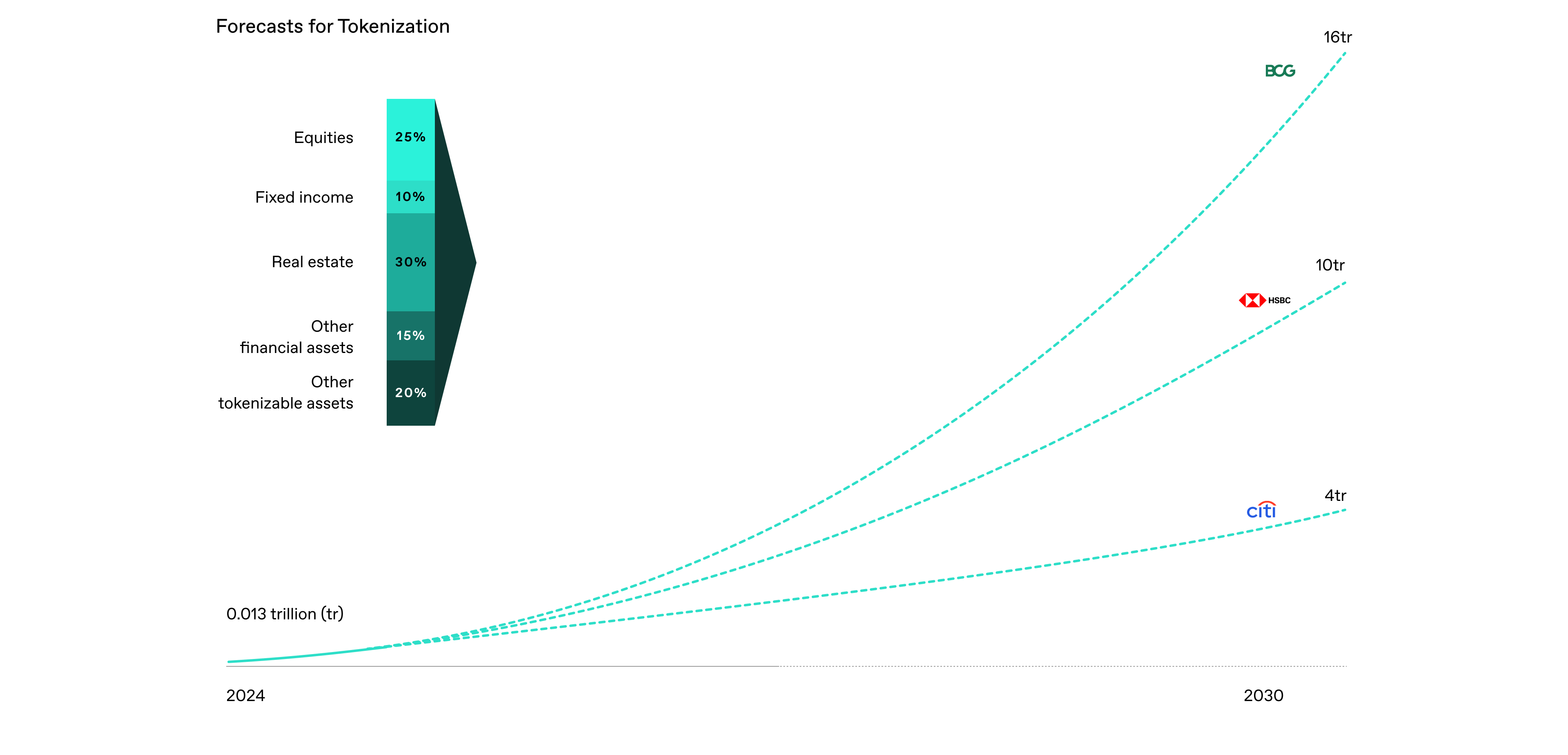
III. Institutional Titans Leading the Charge

Industry leaders are not just acknowledging this shift—they're spearheading it. BlackRock CEO Larry Fink highlighted the transformative potential of tokenization in his 2023 annual letter to shareholders:
"The tokenization of asset classes offers the prospect of driving efficiencies in capital markets, shortening value chains, and improving cost and access for investors."⁹
Larry Fink, CEO of BlackRock
Following the approval of BlackRock's Bitcoin ETF in January 2024, Fink remarked on CNBC:

"We believe the next step will be the tokenization of every financial asset."¹⁰
Larry Fink, CEO of BlackRock
Demonstrating their commitment, in March 2024, BlackRock launched BUIDL, their first tokenized fund on the Ethereum blockchain, holding assets like cash, U.S. Treasury bills, and repurchase agreements. Within four months, BUIDL surpassed $500 million in market value, reflecting strong market appetite. Similarly, Franklin Templeton introduced the BENJI token, representing shares of their tokenized money market fund, signaling the industry's decisive shift towards tokenization.
IV. The Dawn of Widespread Tokenization
While challenges like regulatory uncertainties remain, rapid advancements and increasing institutional support are paving the way for widespread tokenization. A diverse array of assets is already being tokenized, including:
| Category | Examples | Tokenizing companies |
|---|---|---|
| Real Estate | Residential, Commercial, REITs | Estate protocol, RealT, SolidBlock, Lofty.ai |
| Commodities | Gold, Silver, Precious Metals, Oil, Natural Gas | Paxos (PAX Gold), Tether Gold (XAUT), DigixGlobal, Mattereum |
| Artwork & Collectibles | Fine Art, Luxury Goods (watches, cars), Rare Collectibles (memorabilia, wines) | Masterworks, 4ARTechnologies, Artemundi, Rally, CurioInvest, Unikura |
| Equities | Stock Tokens | Dinari, Polymath, tZERO, Backed, Bakkt, Binance |
| Bonds | Government and Corporate Bonds | Ondo, Matrixdock, Backed, Franklin Templeton, Swarm, JST, Centrifuge Maple, Agora, Marex |
| Debt Instruments | Mortgages, Personal Loans | Tranched, Centrifuge, Figure Technologies, AAVE, Maple Finance, Blackrock, Backed, Goldfinch |
| Intellectual Property | Music Royalties, Film & Media Rights | Royal, ANote Music, Opulous, Vezt |
| Infrastructure | Energy Projects (solar, wind), Transportation, Utilities | EnergiMine, Sun Exchange, WePower, Power Ledger |
| Agriculture | Farmland, Crops, Produce | LandX, AgroToken, AgriChain, Cultivo |
| Supply Chain Assets | Inventory Financing, Commodities in Transit | Morpheus.Network, TradeLens, Skuchain, IBM Blockchain |
| Insurance Policies | Life Insurance, Parametric Insurance | Chainlink (parametric insurance), Etherisc, Nexus Mutual |
| Revenue Streams | Cash Flows from Businesses, Royalty Tokens | Royalty Exchange, Centrifuge, Superfluid |
| Carbon Credits | Emission Allowances, Tokenized Carbon Credits | KlimaDAO, Toucan Protocol, Moss.Earth, Flowcarbon |
| Land & Natural Resources | Timberland, Mineral Rights | Fabrica, Landshare, Carbonland Trust, Akoin |
| Securitized Loans | Consumer Debt, Business Loans | Centrifuge, Credix, Maple Finance |
As these assets are tokenized and brought onchain, the common questions will be: how can the value of my asset be unlocked? Where can it be more productive, generating yield? Where can it be used as collateral for a loan? Ripe solves that.
Competitive
Landscape

Summary
Most major lending protocols struggle to support real-world assets due to compliance requirements or NFT compatibility.
Earning yield on tokenized assets: Currently, no alternative methods exist in DeFi to generate yield on tokenized real-world assets. Ripe Protocol is the first to unlock this capability on previously idle assets.
Earning yield on crypto-native assets: Ripe's extensible deposit framework transforms potential competitors into partners (via integration).
Borrowing with pooled money market protocols (Aave, Compound, Morpho)
Struggle to support real-world assets due to compliance or NFT incompatibility.
Lender dependency leads to unpredictable rates.
Greater collateral risk as deposits can be borrowed by others.
Borrowing with CDP-based protocols (Maker, Liquity)
This model is most similar to Ripe as it includes a synthetic USD stablecoin
Do not support diverse collateral assets, especially RWAs and yield-bearing positions from other protocols.
Borrowers must manage multiple loans for each asset, whereas Ripe allows a single loan backed by multiple assets.
Borrowing with P2P NFT protocols (Blur, NFTfi, Arcade)
Only support NFTs as collateral.
Each asset requires a different loan, making portfolio management cumbersome.
Each loan requires a lender, leading to fragmented liquidity and higher borrower rates.
Ripe Protocol offers the ability to earn yield on any asset, as well as the ability to borrow against any asset. Below, we examine the competitive landscape for each use-case.
I. Earning Yield: Turning Competitors into Partners
Integration Over Competition
Ripe's extensible deposit framework transforms potential competitors into integration partners. Through governance, popular lending markets and yield aggregators—such as Aave, Maker, Compound, MetaMorpho, Gearbox, Yearn, and Beefy—can be seamlessly added as yield strategies. Ripe users can also borrow against these yield-bearing positions, eliminating the need to choose between Ripe and other platforms. Those seeking yield don't have to pick sides; they get the best of all worlds with Ripe.

Pioneering Yield on Tokenized Assets
For most tokenized real-world assets—especially non-fungible or regulated ones—there are currently no methods to generate yield in DeFi or traditional finance. Ripe Protocol is the first to unlock this potential, transforming previously idle assets into productive, yield-generating ones. This unique capability is made possible through Ripe’s Endaoment and Bonding Mechanism.
II. Borrowing Against Assets: Ripe's Competitive Edge
The borrowing landscape is competitive, primarily divided into:
Money Market Protocols
Collateralized Debt Position (CDP) Protocols
Peer-to-Peer NFT Lending Protocols
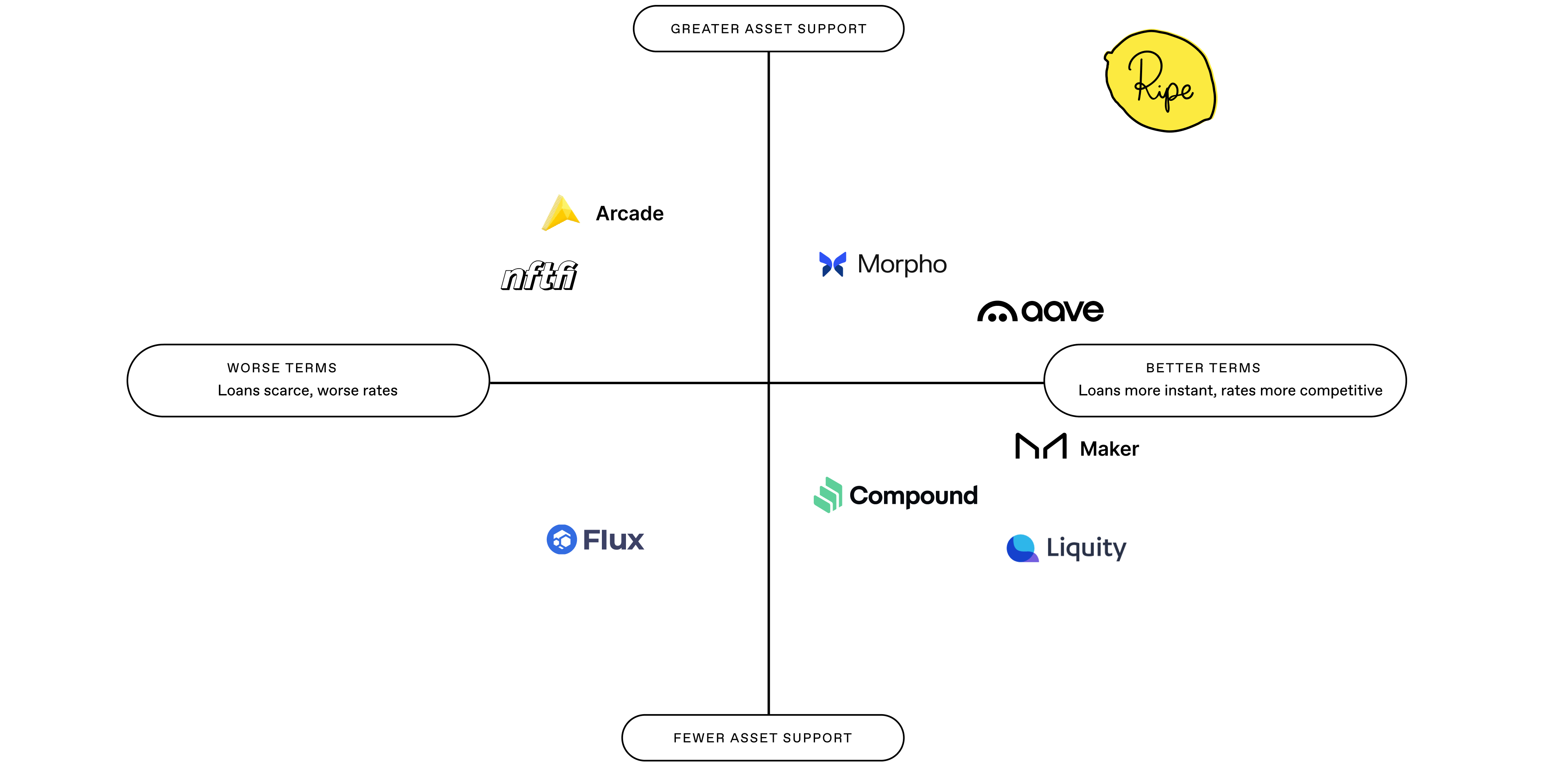
Money Market Protocols
Key players in money market protocols include Aave, Compound, Morpho Blue, and Fluid. Due to their historical success and ease of bootstrapping, most new DeFi lending entrants replicate this money market model.
Protocols like Aave and Compound have been widely forked across networks, dominating lending on many EVM-based Layer 1 and Layer 2 chains. Examples of these forks are Spark (an Aave fork on Ethereum Mainnet), Venus (a Compound fork on Binance Smart Chain), Benqi (a Compound fork on Avalanche), and Moonwell (a Compound fork on Base).

Strengths
Multi-Asset Collateralization: Borrowers can use multiple assets as collateral for a single loan.
Direct Asset Access: Immediate access to the desired asset without additional swaps.
Risk Isolation: Isolated markets offer a wider variety of collateral by isolating risk per asset.
Weaknesses
Liquidity Dependence: Loans depend on available liquidity; insufficient liquidity can prevent borrowers from obtaining desired amounts.
Volatile Interest Rates: Rates fluctuate unpredictably based on pool liquidity and utilization.
Limited Asset Support: Cannot accommodate many tokenized real-world assets, especially regulated or non-fungible ones.
Deposit Risks: Users risk losing collateral due to hacks or price manipulation, as deposits can be borrowed by others.
Exclusion of Long-Tail Assets: Typically exclude less common assets, limiting options.
Complex Loan Management: Isolated pools require managing multiple loans, complicating user experience.
How Ripe Stands Out
Diverse Asset Support: Ripe supports a wide range of collateral, including long-tail assets and tokenized real-world assets.
Immediate Loan Access: Users receive instant loans by minting GREEN, a synthetic US dollar stablecoin, without relying on lenders.
Predictable Debt Terms: Stable and predictable interest rates, unaffected by liquidity fluctuations.
Enhanced Security: Collateral remains secure; users cannot borrow others' deposits.
Collateralized Debt Position (CDP) Protocols
Key players include Maker (Sky), Liquity, Curve Lend, Abracadabra. While Maker is the largest, it is moving away from the CDP model for end-users by deprecating many collateral assets and focusing on issuing DAI to external systems. Maker has partnered with DeFi money markets like Aave, Spark, and Morpho, supplying DAI to their pools. It is also issuing DAI to off-chain entities like banks and funds, which raises concerns about accountability and transparency.

Strengths
Immediate Loan Access: Loans are instant, with no lender dependencies.
Predictable Debt Terms: Stable interest rates, independent of liquidity.
Weaknesses
Complex Loan Management: Borrowers must manage separate loans for each asset, increasing complexity and liquidation risk.
Limited Asset Support: Similar limitations in supporting diverse tokenized assets.
Extra Transaction Steps: Need for swaps or exchanges due to synthetic stablecoins.
How Ripe Stands Out
Unified Collateralization: Borrowers can collateralize multiple assets in a single loan, simplifying management and reducing risk.
Broad Asset Support: Includes long-tail and tokenized real-world assets, overcoming competitors' limitations.
Peer-to-Peer NFT Lending Protocols
This has only been relevant when borrowing against NFTs. Key players include Blur Lending, NFTfi, Arcade. None of them have seen significant traction.

Strengths
Support for Diverse Assets: Can accept various NFTs, including tokenized real-world assets.
Weaknesses
Liquidity Dependence: Borrowers must wait for willing lenders for each asset.
Unfavorable Debt Terms: Scarce liquidity leads to predatory interest rates.
Complex Loan Management: Separate loans for each asset increase complexity and risk.
How Ripe Stands Out
Multi-Asset Collateralization: Collateralize multiple assets in one loan, enhancing efficiency.
Immediate Loans: Minting GREEN allows instant access to funds without lender dependency.
Stable Debt Terms: Predictable interest rates, independent of liquidity conditions.
Go To Market

Summary
Our growth strategy leverages strategic partnerships with asset tokenizers and consumer-facing platforms, adopting a B2B2C model.
Launch Phase
Goal: Smooth launch, deeper GREEN liquidity, RIPE token distribution.
Target Audience: crypto-native users
Offering: Low-risk assets (blue chip crypto, some permissionless RWA)
Strategy: RIPE token incentives, existing networks for promotion.
When: First few months
Phase 1
Goal: Deeper integration with partners (RWA asset issuers)
Target Audience: crypto-comfortable users, RWA holders
Offering: Permissioned RWAs (money market funds, public equities, private credit), non-fungible RWAs (real-estate, luxury items), unique crypto assets (yield-bearing positions, DEX LP, etc)
Strategy: co-promotion w/ RWA partners, integration w/ asset issuer platform
When: Year 1
Phase 2
Goal: Power yield and credit functionality in consumer web 2.0 applications
Target Audience: Consumer Applications like exchanges (coinbase), fintech apps (PayPal, SoFi), and neobanks (Revolut, N26)
Offering: Infrastructure tools like APIs, web services, and SDKs for easier integration
Strategy: strategic partnerships with wallet/custody providers (Fireblocks, BitGo, etc), leverage relationships w/ existing asset issuers, credibility and case studies
When: Year 2
Phase 3
Goal: Launch a dedicated L2, broader institutional adoption
Target Audience: Institutional asset managers (BlackRock, Apollo) and TradFi institutionals (JP Morgan, Goldman)
Offering: L2 blockchain optimized for RWA issuance, compliance, application development
Strategy: dedicated support, leverage established partners from phase 1/2, growth flywheel
When: Year 3
Our growth strategy harnesses strategic partnerships with asset tokenizers and consumer-facing platforms—including fintechs, exchanges, and wallets—following a B2B2C model. While asset issuers invest heavily to bring real-world assets on-chain, they often struggle to unlock their full utility in DeFi. Ripe Protocol bridges this gap, enabling them to fully leverage their tokenized assets. For consumer applications (Phase 2), Ripe introduces new product use-cases centered on yield and credit. We are confident that Ripe will serve as valuable infrastructure for our partners, catalyzing the protocol's growth. Our go-to-market approach unfolds in four phases, each expanding our audience and building on the success of the previous stage:
Successful Launch with Low-Risk Assets and Permissionless RWAs for Crypto-Native Users (Web3)
Permissioned, Non-Fungible RWAs and Unique Crypto Assets for Crypto-Comfortable Users (Web 2.5)
Powering Yield and Credit for Consumer Applications (Web 2.0)
Launch Dedicated Layer 2 and Broader Institutional Adoption
Launch Phase
Web 3
Successful Launch with Low-Risk Assets and Permissionless RWAs for Crypto-Native Users
Objectives
Ensure a Smooth Launch: Fine-tune parameters, validate economic models, and progressively lift operational limits.
Deepen GREEN Liquidity: Expand our stablecoin's liquidity to meet borrower demand and uphold a strong $1 peg.
Distribute RIPE Tokens: Strengthen onchain governance by broadening RIPE token distribution.
Target Audience
Sophisticated DeFi Users: Individuals experienced in yield farming, airdrop hunting, and providing liquidity on DEXs.
Risk-Tolerant Investors: Users who understand early-stage protocol risks and are motivated by potential high rewards.
Offering
Low-Risk Crypto Assets: Access to stablecoins (USDC, USDT), major cryptocurrencies (ETH, wBTC), and leading DeFi tokens (LINK, UNI).
Blue-Chip Yield Strategies and LSTs: Inclusion of assets like sDAI, sUSDE, stETH, and rETH.
Permissionless RWAs: Availability of tokenized treasuries and yield-bearing stablecoins.
Strategy
Investor and KOL Promotion: Utilize our VCs, angel investors, and advisors to promote the launch through their networks. This strategic capital raise supports our promotional efforts.
Community Promotion: Activate our existing community and connect with adjacent communities to amplify our message.
RIPE Token Incentives: Provide generous early-phase RIPE token emissions to encourage participation in deposits, borrowing, and liquidity.
Phase 1
Web 2.5
Permissioned, Non-Fungible RWAs and Unique Crypto Assets for Crypto-Comfortable Users
Objectives
Diversify Asset Support: Introduce a wide array of assets, including regulated RWAs, non-fungible RWAs, and unique crypto positions.
Strengthen Strategic Partnerships: Deepen collaborations with asset issuers and integrated DeFi protocols.
Target Audience
Crypto-Comfortable Users: Individuals familiar with wallets and self-custody who prefer established over experimental protocols.
Real-World Asset Holders: Users interested in tokenizing their assets or acquiring tokenized assets, recognizing DeFi's potential benefits.
Offering
Permissioned RWAs: Access to assets with compliance requirements, such as money market funds (Superstate, Securitize), public equities (Backed, Dinari), and private credit (Maple, Centrifuge).
Non-Fungible RWAs: Tokenized land (Fabrica), real estate (Estate Protocol), and luxury collectibles represented by NFTs (SegMint).
Unique Crypto Assets: Yield-bearing positions in other money markets, DEX LP positions (Uniswap, Curve), and long-tail assets (wrapped L1 tokens, governance tokens, memecoins).
Strategy
Collaborate with Partners: Work with asset issuers to promote Ripe Protocol to their customer bases via newsletters, social media, and onboarding processes.
Enhance User Experience: Develop seamless integrations with RWA partners, allowing users to earn and borrow directly within issuer platforms.
Foster User Advocacy: Encourage satisfied users to refer others, attracting more asset issuers and expanding our reach.
Establish Thought Leadership: Produce educational content that helps asset issuers understand tokenization and the unique value Ripe provides.
Phase 2
Web 2.0
Powering Yield and Credit for Consumer Applications
Our firsthand experience building Hightop—a consumer neobank that reached $100 million in AUM—highlighted the industry's need for a solution like Ripe Protocol. Existing DeFi protocols lacked the ability to offer yield from a variety of assets and strategies while providing unified borrowing against those positions. We believe that DeFi will achieve mass-market adoption through centralized, mobile apps rather than decentralized apps or non-custodial wallets (see Further Reading near footnotes to better understand our thesis here).
Objectives
Showcase Integration Capabilities: Demonstrate that Ripe Protocol can seamlessly power yield and borrowing features for consumer applications.
Enhance User Engagement: Prove that Web 2.0 users desire functionalities beyond basic buying, selling, and holding of digital assets.
Target Audience
Consumer Applications: Exchanges (e.g., Coinbase, Robinhood), fintech apps (e.g., PayPal, Cash App, SoFi), and neobanks (e.g., Revolut, N26) seeking differentiation and growth through expanded offerings.
End Users: Millennials and Gen Z users looking for superior financial tools within the convenience of centralized mobile apps.
Offering
Advanced Infrastructure: Provision of APIs, web services, SDKs, developer tools, and comprehensive documentation to facilitate integration.
Strategy
Form Strategic Partnerships: Engage with custody and wallet providers like Fireblocks, Anchorage, BitGo, and Copper to streamline adoption by consumer platforms.
Utilize Existing Relationships: Leverage connections with asset issuers from earlier phases for introductions and endorsements.
Scale Market Penetration: Gradually ascend the consumer app landscape, building credibility and showcasing success stories to reach platforms with millions of users.
Phase 3
Launch Dedicated Layer 2 and Broader Institutional Adoption
Objectives
Bridge Tokenized Assets and Consumers: Connect the value and accessibility of tokenized assets with mass-market consumers via Web 2.0 partners.
Achieve Global Scale: Realize our vision of unlocking the value of global assets on a massive scale.
Target Audience
Developers and Asset Issuers: Institutional asset managers, real-world asset issuers, builders, and entrepreneurs seeking innovative platforms.
Financial Institutions and Platforms: Entities ready to build on the momentum established in Phase 2.
Offering
Optimized Layer 2 Platform: A dedicated blockchain optimized for issuing new tokenized assets and building applications around them, addressing specific compliance and performance needs.
Enhanced Integration Tools: Advanced APIs and web services offering superior performance and extensibility.
Strategy
Leverage Established Partnerships: Collaborate closely with existing partners to facilitate smooth migration and integration.
Provide Comprehensive Support: Offer extensive documentation, interactive Q&A sessions, and consider RIPE token incentives or grants.
Create a Growth Flywheel: Encourage asset issuers and developers to utilize Web 2.0 distribution channels, fostering a cycle of increased assets, better applications, and heightened innovation.
Business Model

Summary
Ripe Protocol is engineered for long-term sustainability.
Revenue potential is significant, as evidenced by leading DeFi lending protocols: Aave generated $313 million, and Maker generated $233 million in revenue over the past year.
By targeting $50 billion in deposits and $30 billion in loans, Ripe aims to generate $1.8 billion in annual interest revenue.
In our first year post-launch, we aim to achieve $50 million in protocol deposits, $35 million in loans originated, and $3.5 million in Endaoment value
Revenue streams include borrow interest, origination fees, liquidation fees, redemption fees, and deposit exit fees.
All revenue flows into the Endaoment, where the principal is invested, and yield is distributed as governed by RIPE token holders.
The RIPE token serves both utility and governance functions, enabling holders to direct Endaoment investments, Endaoment yield distributions, and protocol rewards, aligning their interests with the protocol's success.
Sustainable Growth and Revenue Potential
Ripe Protocol is engineered for long-term sustainability. While RIPE tokens will initially subsidize DAO operations, the protocol's inherent revenue streams ensure profitability in the long run.
Benchmarking Against Industry Leaders
Comparing Ripe Protocol to leading lending protocols underscores its potential:

Aave
With $12.98 billion in deposits and $8.12 billion in active loans, Aave generated $313.6 million in revenue over the past year. After payouts to lenders, $74.5 million accrued to the Aave DAO. The AAVE token boasts a fully diluted market cap of $2.5 billion.

Maker (Sky)
Managing $8.9 billion in deposits and $5.9 billion in DAI/USDS, Maker generated $233.51 million in revenue last year, with $143.8 million accruing to Maker DAO. The MKR token has a fully diluted market cap of $1.2 billion.
These impressive figures demonstrate the significant revenue potential for protocols like Ripe, rivaling many public tech companies.
What Ripe Can Become
| Deposits | Loan Book | Interest Revenue |
|---|---|---|
| $50 Billion | $30 Billion | $1.8 Billion |
As discussed in the Market Opportunity section, analysts predict that the total value of assets brought onchain through tokenization could reach between $8 trillion and $16 trillion by 2030. This projection far exceeds the current $2 trillion market that protocols like Aave and Maker serve today (major cryptocurrencies).
To estimate Ripe Protocol's potential, let's examine Aave's current market penetration. Aave manages $13 billion in deposits within a $2 trillion market, equating to a market share of 0.65%. This percentage reflects Aave's position as a market leader in their category.
Applying the same 0.65% market penetration rate to the conservative $8 trillion estimate for tokenized real-world assets, we could aim for a deposit base of approximately $50 billion.
Assuming a 60% loan-to-value ratio, this would result in a loan book of approximately $30 billion. With an average interest rate of 6%, Ripe Protocol would generate $1.8 billion in annual revenue from borrower interest, accruing to the Endaoment. When the Endaoment reaches $3 billion in assets, it will be producing $90 million in recurring annual yield (conservative 3% APY). Through governance, RIPE token holders will decide how this yield is allocated.
Capturing even a fraction of a percent of this market translates into significant deposit and revenue figures, rivaling or exceeding those of current industry leaders.
First-Year Milestones
We aim to achieve the following key benchmarks in Ripe’s first year post-launch:
$50 million in protocol deposits: Attract a wide user base through a diversified deposit strategy—including real-world assets (RWAs), stablecoins, NFTs, and liquidity provider (LP) positions.
$35 million in loans originated: Drive loan origination with competitive lending terms, user-friendly liquidation tools, and access to credit for underutilized assets.
$3.5 million in Endaoment value: Accumulate proceeds from bonding, loan interest, and protocol fees within the Endaoment, establishing a solid foundation for sustainable revenue and future growth.
Diverse Revenue Streams
Ripe Protocol generates revenue through multiple channels:
Borrow Interest: Collected upon loan repayment; unpaid interest is considered a receivable asset.
Origination Fees (Daowry): Charged when borrowers initiate loans.
Liquidation Fees: Applied to borrowers whose assets are liquidated.
Redemption Fees: Incurred when users redeem GREEN tokens for Endaoment positions.
Deposit Lock Exit Fees: Paid when users withdraw locked deposits early.

The Endaoment: Sustainable Yield Distribution
All protocol revenue flows into the Endaoment. Like traditional endowments, the principal remains invested while the generated yield is distributed sustainably. RIPE token holders govern the Endaoment's investment strategies and decide how to allocate the yield. Distribution options include:
Depositors: Allowing users to "earn yield on anything."
Stability Pool Participants: Incentivizing users who deposit GREEN or GREEN LP tokens.
Governance Stakers: Rewarding users who stake RIPE or RIPE LP tokens.
Contributors: Supporting DAO members in supervisory governance roles.
Impact Initiatives: Donating to charitable causes.

Efficient Operational Costs
Ripe Protocol operates with relatively low overhead, keeping DAO operating costs minimal. Expected expenses include:
Operational Expenses: Covering onchain governance activities requiring gas fees.
Team Salaries: Supporting the existing team of five people.
Staff Expansion: Hiring for software development, business development, data science, risk analysis, legal, and marketing.
Security & Safety: Funding ongoing code audits, bug bounty programs, and white-hat hacker initiatives.
Legal Expenses: Managing compliance and partnerships with asset issuers (RWA) and Web 2.0 partners.
Marketing Efforts: Producing educational content, attending events, and executing targeted media campaigns.
RIPE Token Value and Governance
RIPE token holders govern the Ripe Protocol through decentralized, on-chain governance. As a true DAO, it is entirely controlled, owned, and managed by the community, with no admin keys or multi-sigs. Ripe's governance system is one of its most unique and defining features.
Governance Powers of RIPE Token Holders include:
Endaoment Investment Allocations: Decide how Endaoment assets are invested, steering investments for collective benefit.
Yield Distributions: Determine how to distribute interest earned from the Endaoment, incentivizing preferred strategies and activities.
RIPE Emissions: Control protocol activities receiving RIPE block rewards, shaping the future supply distribution.
Depositor Rewards: Decide which specific assets deposited in Ripe Protocol should receive rewards (Endaoment Yield or RIPE emissions).
By directing economic benefits resulting from protocol activities, RIPE tokens serve both utility and governance functions. As the protocol succeeds, the value of governing with RIPE tokens is designed to increase, aligning the interests of token holders with Ripe Protocol's long-term success.
Further Reading
Phase 2 of our Go To Market strategy involves working with and powering yield/credit functionality in Web 2.0 consumer applications. During the Covid pandemic and while working on Hightop, Mick did a content series on why this is the winning strategy for helping DeFi reach the masses.
How Any Protocols Reach Mainstream Adoption: Exploring why crypto protocols will follow traditional adoption paths.
In Search of the Killer Application: Identifying the type of app that will bring crypto to the masses and why it may not be decentralized.
The Winning Strategy For Broader Adoption: Analyzing methods crypto apps use to reach the masses and common industry pitfalls.
Why Crypto Normies Need a Bank: Discussing why centralized, Web 2.0-style applications are key to mass adoption of crypto/DeFi.
Footnotes
1. Ernst & Young Report: Tokenization of Assets
2. RWA.xyz - Tokenized Treasuries Dashboard
3. BNY Mellon and Celent Survey: Migration to Digital Assets Accelerates
4. BCG and ADDX Report: On-Chain Asset Tokenization
5. 21.co Report: The State of Tokenization
6. Northern Trust & HSBC Report: Beyond Asset Tokenization
7. Citigroup Report: Future of Money: Tokenization
8. JPMorgan & Bain & Co Report: How Tokenization Can Fuel a $400 Billion Opportunity
9. Larry Fink's 2023 Annual Letter to Shareholders
10. CNBC Interview with Larry Fink, January 2024: BlackRock's Bitcoin ETF Approval and the Future of Tokenization



